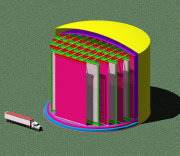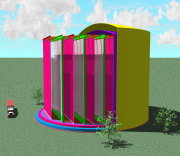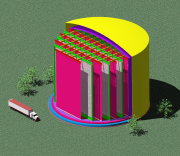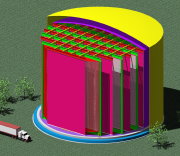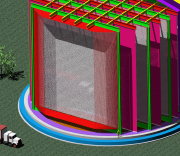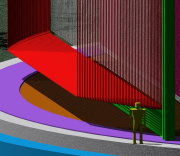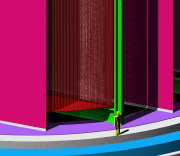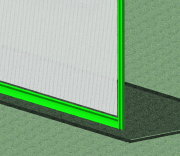|
Conceptual Design of the FLARE detector These pictures show the first design BE created of a 150 kton Liquid Argon TPC for the fledgling FLARE collaboration. The design is very conceptual and was done for Adam Para of FNAL to show at talks to generate interest in the concept. It is not intended to show the current state of the design, but is a historical record of the very beginning of the FLARE concept. The model was created with Autodesk Mechanical Desktop and rendered with Accurender 3.1. I just love it when I get the chance to use the fractal trees in Accurender! This experiment was originally conceived as an off-axis neutrino experiment using the NuMI neutrino beam. The off-axis position could be in Canada north of the line connecting Fermilab and the MINOS detector in Minnesota. The experiment is large enough and possibly sensitive enough that it could also be used as a proton decay experiment. Click on any of the thumbnails to get an enlarged view. You are welcome to download any of the images. If they are used for other than private viewing, credit to Bartoszek Engineering would be appreciated.
The detector is a very large liquid argon TPC built inside a tank similar to the very large LNG tanks in terminals in Japan and other countries. The vessel is too large to be evacuated to clean it. The vessel is double walled, but the insulating space is filled with pearlite instead of vacuum as in smaller cryostats. The truck is there for scale, as are the trees. The principal of the Time Projection Chamber is that electrons can drift long distances (meters) in ultra-pure liquid argon. If a large electric field gradient is applied between cathode planes and wire planes, the electrons will drift toward the wire planes and create a signal on the wires which is read-out. The tracks of particles which ionize and release electrons in the argon can be reconstructed from the signals on the wires.
The tube frames shown in these images are the field shaping electrodes which help create a uniform electric field between the cathode foils and the wire planes. It's somewhat hard to give a perspective on just how big this detector is. I wasn't able to finish the modeling of the tubes due to time constraints, but they would exist between each pair of cathodes and wire planes.
I cheated on the modeling of the wire planes in what I thought was a clever way. Instead of modeling the tens of thousands of wires that this detector will have, I simply modeled plates inside the structural steel framework. I assigned a mesh material from the Accurender library to the plates to give the impression of an array of wires. Accurender produced just the effect I was looking for with the semi-transparent mesh. The actual wire mounting and readout is a currently unsolved and tricky problem. Back to the Bartoszek Engineering Projects Page Back to the Bartoszek Engineering Home Page |

